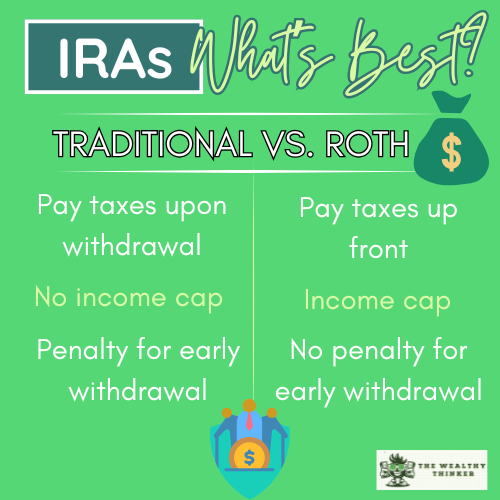Planning for retirement is one of the most important financial decisions you’ll make, and choosing the right Individual Retirement Account (IRA) is a critical part of that process.
Two popular options—Traditional IRAs and Roth IRAs—offer unique advantages, and the right choice depends on:
- your financial situation
- your goals
- how you prefer to handle taxes
Should you opt for the immediate tax savings of a Traditional IRA or the long-term tax-free growth of a Roth IRA?
Understanding the pros, cons, and key differences between these two options will empower you to make the best decision for your retirement journey.
In this article, we’ll break down how each account works, the benefits and drawbacks of each, and what factors to consider when deciding which IRA aligns with your financial future.
Let’s dive in and discover which path to retirement security is the right fit for you!

What is a Traditional IRA?
A traditional Individual Retirement Account allows you to contribute pre-tax income to any stock, bond, mutual fund, and more that you choose to invest your money into.
This money will grow, and you will not have to pay taxes on the growth while you are still contributing. However, you will have to pay taxes on the money you withdraw once you are of retirement age.
3 Pros of a Traditional IRA
A traditional IRA’s main advantages are:
- tax-free growth
- pre-taxed contributions
- no income cap
In addition, this retirement account allows you to avoid paying taxes for as long as possible. For example, if you started an account at 18, you could not pay taxes until you are 59 1/2.
1. Tax-free growth
The contributions you put into your traditional IRA will grow tax-free.
You will not have to pay taxes on the growth of your account until you are retirement age and can withdraw. This can put you in a lower income tax bracket when you have to pay taxes at the age of 59 1/2.
2. Pre-taxed contributions
Similar to tax-free growth, your contributions towards your traditional IRA are pre-taxed.
You do not pay taxes on your contribution amount until you withdraw. People with a higher income tax try to avoid paying taxes in this higher tax bracket and would rather pay taxes during retirement at a lower income tax bracket.
3. No income cap
A traditional IRA does not have an income cap, unlike a Roth IRA.
Therefore, anyone with any income can contribute to a traditional IRA. This is ideal if you are over the income cap for a Roth IRA and still need to contribute towards your retirement.
3 Cons of a Traditional IRA
While avoiding paying taxes is a huge advantage, some disadvantages to a traditional IRA may be a deal breaker for some people.
These are contribution limits, paying taxes on gains, and early withdrawal penalties.
1. Contribution limit
For tax years 2024 and 2025, both traditional and Roth IRAs have a contribution limit of $7,000 (if you’re under age 50) and $8,000 (if you’re age 50 or older).
Therefore, if you plan to invest more than this, you’ll need to have more than one personal retirement account.
2. Taxes on gains
Because you have not paid any taxes on your contribution, you will have to pay taxes on your entire account as you withdraw.
This means all of your contributions and gains will have to be taxed. However, the gains on a Roth IRA will not be taxed, since you’ve paid taxes on your contributions.
3. Early withdrawal penalty
Unlike a Roth IRA, where you can withdraw your contributions with no penalty, you cannot withdraw early in a traditional IRA without a penalty.
The penalty on early withdrawals is 10% – in addition to taxes. So if you think you may need an early withdrawal, the fee and taxes could significantly reduce the amount of money you will get.
What is a Roth IRA?
A Roth Individual Retirement Account allows you to contribute taxed income into any stock, bond, mutual fund, and more that you choose to invest your money into.
This money will grow tax-free. When you withdraw your month at retirement age, you will not have to pay taxes on any growth or withdrawals.
2 Pros of a Roth IRA
A Roth IRA has two main advantages – tax savings and the ability to withdraw your contribution at any time. For some folks, these two reasons alone are why they choose a Roth IRA over a traditional IRA.
1. Tax Savings
A Roth IRA has substantial tax savings.
Because this account is Roth, you pay taxes on all of your contributions. When you withdraw your gains, you will not have to pay any additional taxes.
Some people believe that taxes will increase, even if they are retired, and in a lower tax bracket, so it’s better to pay taxes now on the contributions and not pay taxes on the growth.
A person with a traditional IRA will pay contributions and growth taxes when the money is withdrawn.
If you start investing in a Roth IRA at a young age, your account could be worth a lot due to compound interest, and you will not owe taxes.
2. Withdraw Contributions
You are able to withdraw your contributions at any time without penalty in a Roth IRA.
While you cannot replenish what you took out, it can be helpful if you are not retirement age and you need money. Since you’ve paid taxes on these contributions, you also will not have to pay additional taxes.
However, any gains you’ve made in your Roth IRA account cannot be withdrawn.
3 Cons of a Roth IRA
While tax savings and withdrawing your contributions with no penalty are huge benefits, there are some downsides to a Roth IRA.
There are contribution limits and income caps, and paying taxes at a higher tax bracket can be deal breakers for some people.
1. Contribution Limit
As we mentioned before, for tax years 2024 and 2025, both traditional and Roth IRAs have a contribution limit of $7,000 (if you’re under age 50) and $8,000 (if you’re age 50 or older).
If you want to save more than this annually in a retirement account, then you will have to have more than one account. Luckily, most investment companies, like Fidelity, can allow you to create these accounts in one place.
2. Income Cap
A Roth IRA has an income cap, meaning you cannot open up or contribute to this account if you make over a certain amount.
For 2025, if you are single and make over $150,000 or are married and make over $236,000, then you cannot contribute to a Roth IRA for that year. If you were making less than this income cap, then you can still keep your Roth IRA open, but you cannot add to it.
3. Taxed Contributions
While some people see having your contributions taxed for a Roth IRA as a positive, there are also people on the other side who see this as a significant disadvantage.
This is because you will be taxed at your current income bracket instead of possibly being taxed later with a lower income tax track bracket.
Some people want to avoid paying taxes now and want to wait when taxes could be lower at retirement age.
Final Thoughts on Traditional IRA vs Roth IRA
You cannot go wrong with opening up either a traditional IRA or Roth IRA because saving for your retirement is so important.
It’s an individual decision if you want to contribute pre-tax or taxed income, along with some of the other pros and cons of both accounts. Being able to withdraw your contributions with no penalties may be a reason to get a Roth IRA.
On the other hand, the income cap for a Roth IRA may be why someone chooses a traditional IRA.
Editor’s note: This article was originally published Aug 15, 2022 and has been updated to improve reader experience.



















